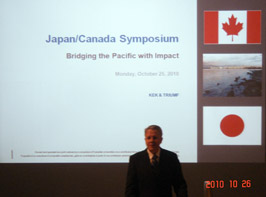Topics
The 2nd Japan/Canada Scientific Symposium held in Vancouver
15 Nov 2010

Mr. Don Fast, the British Columbia Deputy Minister of Small Business, Technology, and Economic Development
On 25 October, TRIUMF in Canada and KEK held a jointly organized symposium to discuss the possibility of future scientific collaborations and partnership across the Pacific Ocean in the areas of accelerator science and technology. The symposium is also intended to maintain and establish consensus and a close relationship between TRIUMF and KEK by encouraging periodic official communication at the highest levels.
Celebrating 80 years of partnership between Canada and Japan, TRIUMF and KEK initiated the first collaboration symposium in July 2009. The first symposium was held at the Canadian embassy in Tokyo, and this is the second symposium in this series.
The symposium was attended by about 80 researchers. Following an introduction by Dr. John Hepburn, Vice President Research at the University of British Columbia, Mr. Don Fast, the British Columbia Deputy Minister of Small Business, Technology, and Economic Development, opened the symposium. Dr. Nigel Lockyer, the Director General of TRIUMF, and Dr. Atsuto Suzuki, the KEK's Director General, then presented an overview of the science and technology programs at each laboratory, featuring projects such as the T2K*1, ATLAS*2, Ultra-Cold Neutron (UCN)*3 study, and MuSR*4 study as major research projects being implemented by the Japan/Canada collaboration.
In the afternoon session, researchers from TRIUMF and KEK gave a series of talks on R&D activities for accelerators and detectors, including the KEKB accelerator, Canada's underground science laboratory specializing in neutrino and dark matter physics, SNOLAB, and the International Linear Collider (ILC), the next generation electron-positron collider.
The closing session of the symposium was a panel discussion chaired by the director of the Washington, D.C. office of the Japan Society for the Promotion of Science (JSPS) and former KEK director, Dr. Hirotaka Sugawara. Panelists discussed challenging topics such as a new model for international laboratories and the stronger expectations for economic and social benefits from basic research. A lively exchange of views among panelists and audience members concluded this successful symposium.
- *1 T2K
- T2K (Tokai to Kamioka, Japan) is a particle physics experiment on neutrino oscillation. The Japan Proton Accelerator Research Complex (J-PARC) produces an intense off-axis beam of muon neutrinos. The beam is directed [straight through the earth] towards the Super-Kamiokande detector, which is 295 km away.
- *2 ATLAS
- ATLAS (A Toroidal Large Hadron Collider ApparatuS) is one of the six particle detector experiments (ALICE, ATLAS, CMS, TOTEM, LHCb, and LHCf) constructed at the Large Hadron Collider (LHC) at the European Organization for Nuclear Research (CERN) in Switzerland. The experiment is designed to observe phenomena that involve highly massive particles that were not observable using earlier lower-energy accelerators, and to test new theories of particle physics beyond the Standard Model.
- *3 Ultra-Cold Neutron (UCN)
- An Ultra-Cold Neutron (UCN) is a neutron that moves quite slowly and is totally reflected from a variety of materials at very low energy. The science opportunities are discussed with emphasis on the nuclear physics related to the neutron's average life span and beta decay, sensitive probes for materials science and their use in various science fields.
- *4 MuSR (Muon Spin Rotation, Relaxation, and Resonance)
- MuSR, or μSR is an experimental technique based on the implantation of spin-polarized muons into matter to investigate its magnetic properties. It makes use of a short-lived subatomic particle called muon, whose spin is exquisitely sensitive to local magnetic field in the matter. MuSR technique is distinguishable by its extreme sensitivity to magnetism and its unique time window for dynamical processes. It also serves sensitive probe for the state of hydrogen, as the muon behaves by itself as an isotope of hydrogen in matter.